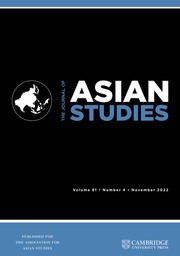Article contents
Notes on Shipping and Trade in Japan and the Ryukyus
Published online by Cambridge University Press: 23 March 2011
Extract
The fact that England, the home of the Industrial Revolution and modern economic growth, was also a leading shipping and trading nation, at one time prompted the notion that flourishing overseas trade and modern economic growth are somehow related. There are, of course, plenty of examples in European history of once flourishing trading nations which failed to industrialize. Spain, Portugal, the Hanseatic ports, and the Italian trading cities never became centres of industry. Moreover, such comparatively industrialized areas as Czechoslovakia and Prussia were not leading trading centres.
- Type
- Articles
- Information
- Copyright
- Copyright © Association for Asian Studies, Inc. 1964
References
1 See Shinen, Tomimura, “Ryūkyū ni okem Min, Nihon to no kankei” [“Ming-Japanese relations in the Ryukyus”], Rekishi Kyōiku, VIII (Oct. 1960), 13–14.Google Scholar
2 Kobata Atsushi, Chūsei Nantō Tsūkō Bōeki-shi no Kenkyū, cited by Sakamaki.
3 Seiichi, Iwao, “Kinsei Nisshi bōeki ni kansuru sūryoteki kōsatsu” [“A quantitative study of Sino-Japanese trade in the pre-modern period”], Shigaku Zasshi, LXII (Nov. 1953), 12–13.Google Scholar
4 Iwao, p. 11.
5 Shigeo, Sakuma, “Min-dai kaigai shi-bōeki no rekishi teki haikei” [“The historical background of private overseas trade in the Ming period”], Shigaku Zasshi, LXII (Jan. 1953), 1–25.Google Scholar
6 Iwao, p. 28.
7 Naojirō, Murakami, Bōekishi-jō no Hirado [Hirado in the History of Trade], (Tokyo: Nihon Gakujutsu Fukyūkai, 1917), p. 102.Google Scholar
8 See Teijirō, Yamawaki, Kinsei Nitchū Bōeki-shi no Kenkyū [Studies in the History of Sino-Japanese Trade in the Pre-modem Periodi, (Tokyo: Yoshikawa Kōbunkan, 1960), p. 97.Google Scholar
9 Application of the wappu system to the Chinese is sometimes dated from 1635; see, for example, Yoshiko, Morioka, “Edo jidai zenki no Nagasaki bōeki” [“Nagasaki trade in the early Edo period”], Rekishi Kyōillu, VIII (Oct. 1960), p. 39.Google Scholar
10 One gan equals 50 kin. Sakai translates this term as “roll.”
- 2
- Cited by


